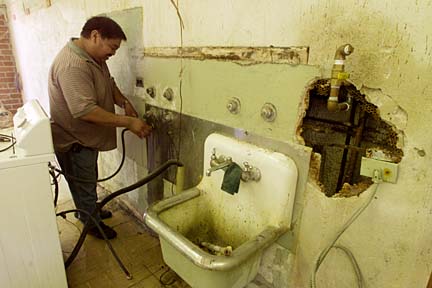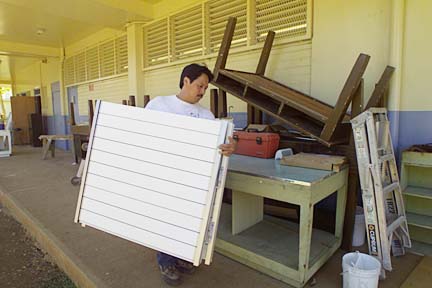


Hawaii schools New legislation and more money will not make a big dent in the $640 million backlog of repair and maintenance projects at the state's public schools.
need a fix
New legislation and more money
may not make a big dent in the
$640 million backlog of repairsBy Crystal Kua
Star-Bulletin"Hopefully in about 10 years, we can catch up with all the maintenance projects," said James Richardson, chief of the Central Services Division of the state Department of Accounting and General Services, which oversees repair and maintenance of public school facilities.
"Now it's a matter of spending wisely and getting the work done."
The 10-year time line, however, depends on the state continuing to fund catch-up projects at $60 million per year.
The state could finish the work within six years if repair and maintenance gets $100 million a year, but that kind of annual funding would be difficult to get, Richardson said. "I think it's going to be a hard pill to swallow."
But while the state plays catch-up, additional money -- $51.8 million a year -- would also be needed for new maintenance projects, or else the state will find itself in the same predicament it is currently in, Richardson said. "We would be right back where we were."
Aging schools, dwindling funding and a focus on new school construction during the past decade are among the factors that led to the deferred maintenance problem of today.
After the backlog reached $240 million two years ago, the state focused on ways to tackle the problem.
Several bills and funding measures passed during the just-completed legislative session were designed to do that.

More money was one answer. State lawmakers allotted $50 million in construction bonds specifically for major backlogged projects, such as re-roofing.Another bill would allow taxpayers to designate $2 of their refunds to school-level repair funds so schools can take care of everyday projects such as fixing broken louvers, dripping water faucets and burned-out lights.
But legislators also looked at ways of overhauling the way the state handles repair and maintenance projects.
One bill would set up two funds -- one to pay for the backlog and one to pay for new projects that come up. The bill also calls for Richardson's department to come up with a six-year plan to map how money would be spent.
The bill would also allow projects under $100,000 to be done after getting estimates from three contractors instead of going through the sometimes time-consuming, prolonged procurement process.
Another measure, supported by U.S. Sen. Daniel Inouye, would bring state, federal and private entities together to try and raise funds and use volunteers, Richardson said.
The bill would also allow companies to get a tax credit for volunteer work done at schools.
A total of $500,000 was allocated for the bill, but the goal is to get private donations to double that amount. "Even if you can get $2 million of work out of $1 million, we welcome all help," Richardson said.
He said his division is also trying to find ways to get more bang out of the repair and maintenance buck.
For example, he has crews currently renovating 58 classrooms at Kalakaua Middle School and 52 classrooms at Dole Middle School.
At Dole, crews will also demolish and repour sidewalks that have been sinking because of settling and age, causing a drop of one-half inch to five inches from door thresholds. The slabs were poured on soft claylike soil and independently of the buildings.
Meanwhile, a new way of doing things and a new source of funding has come from the federal government.
Over the past year, 25 Hawaii public schools attended by military dependents were helped with $5 million from the U.S. Department of Defense. And $5 million more is on the way for next year.
One school that benefited from this funding was Radford High School, which in 1999 was the symbol of the state's repair and maintenance debacle.
The defense money helped renovate Radford's bathrooms and walkways.
It also helped repaint and re-carpet Pearl City Elementary and put new floor tile and a new roof at Hickam Elementary.
"We love this program," state schools Superintendent Paul LeMahieu said.
"(The program) provides more assistance to the schools, speeds up the system's resources and allows the schools to do more repairs and maintenance."
The money is being administered by the U.S. Pacific Command, and the projects are being carried out by the U.S. Army Corps of Engineers Honolulu Engineer District.
"Because of our experience and expertise in fast-track projects, we were able to execute the contracts within a right time frame," said Army Corps project manager Gordon Kuioka.
Projects completed this year included interior and exterior painting, flooring, roofing, renovating bathrooms, carpeting, replacing gutters and grease traps and fixing doors, windows, walkways and lighting.
"It's really quite comprehensive," said spokesman Alex Kufel.
Inouye has been credited with getting the funds as part of this and last year's Defense Department appropriations.